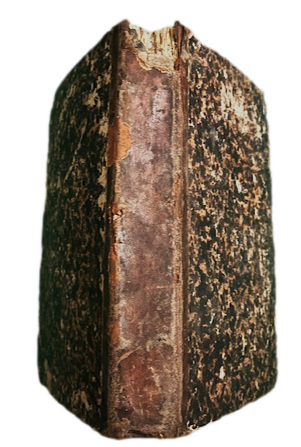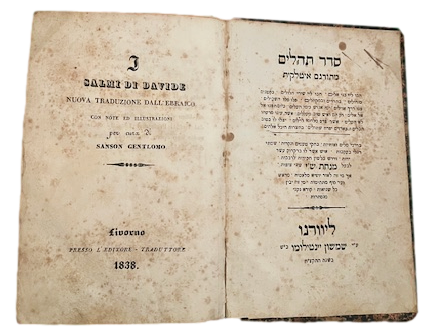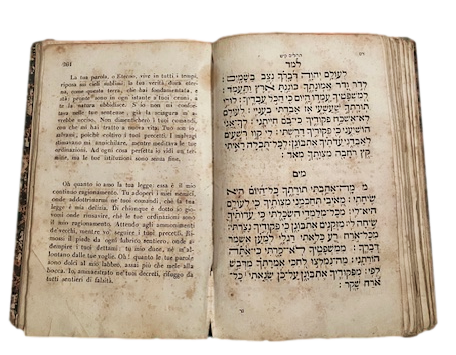In 8°; XVI, 368 pp. Legatura coeva in mezza pelle. Piatti foderati da carta marmorizzata coeva. Testo ebraico con l'italiano a fronte. Doppio frontespizio uno in italiano ed uno ebraico. Qualche segno del tempo alla legatura, qualche leggero foxing all'interno ma nel complesso, esemplare in buone condizioni di conservazione. Prima ed unica non comune edizione di questa traduzione dei salmi di Davide. Secondo la tradizione più accreditata dalla maggior parte degli studiosi i Salmi di Davide sono un'opera composta, raccogliendo diversi testi di varia origine, in Giudea sul finire del III° secolo a. C. L'opera è composta da 150 capitoli con un salmo o inno, ognuno finito in sé. Vi sono salmi di lode, altri di supplica ed altri ancora che contengono meditazioni sapienziali. Il Libro dei Salmi è, infatti, incluso fra i libri detti "Sapienziali" ed è anche conosciuto come Lode o Salteri. Questa rara edizione venne stampata a Livorno dallo stesso editore e traduttore che fu attivo aLivorno nella prima metà del XIX° secolo (a volte compare con il nome Gentilomo Sansoni, Gentilomo Sanson ecc.). il lavoro del quale venne interrotto precocemente per la sua tragica morte a 25 anni. "In 1818, I.S. Reggio met a precocious eighteen-year old S.D. Luzzatto. Their prolific fraternal learned correspondence filled the first volumes of Luzzattos collected Hebrew and Italian letters and a volume of Reggios Hebrew letters to Luzzatto. However, following an intense flurry 1838-1840, such correspondence ended, never renewed. Those letters, mostly published in I.M. Josts Annalen in German translation, marked the crystallization of Luzzattos controversial theological thought pitting Abrahamism of Hazal and Rashi against Atticism of the philosophers and kabbalists. Luzzatto rejected Reggios rationalist responses. When discussion was diverted, Jost abridged it, angering Luzzatto, who announced a monumental letter. In his response to it, Reggios cavalièrement disrespecting Rashi and his school infuriated Luzzatto further and he asked Jost to immediately desist and cancel his own letter, blaming Jost in his closure letter to Reggio. Several months later, a note published in Julius Fürsts Der Orient attacked Gentilomo, a printer of Talmud and Kabballah in Livorno associated with Luzzattos Collegio Rabbinicum (founded by Reggio) where he learned to oppose the great men, Ibn Ezra and Maimonides. Luzzatto responded emotionally to Jost, who published a toned-down version in Annalen, with an editorial note. Luzzattos disciple, Sanson Gentilomo, who had tragically died the previous year at age 25, had been grossly slandered! In the next issue of Der Orient, Fürst castigated Luzzatto and Jost, defending the veracity of the note and its prestigious author,despite errors in details. In the context of contemporaneous disputes in their Wissenschaft circle: Fürsts publication of Modenas Ari Nohem (which plagiarized Reggio), poor reception of Luzzattos Prolegomena, Luzzattos public rift with Rapoport, and other evidence, Reggio emerges as the author indicated by Fürst. Whether or not it was Reggio, the incident contributed to the long, silent schism with Luzzatto, known to them alone, Fürst, and possibly Jost." Leor Jacobi, Defending a Dead Disciple, Heidelberg, 2019. Esemplare in buone condizioni di conservazione, non comune. Rif.Bibl.: IT\ICCU\RMS\0086317.



Découvrez comment utiliser
Découvrez comment utiliser

